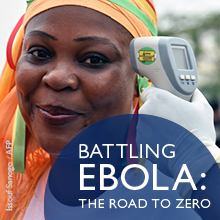From November 25th (International End Violence Against Women Day) through December 10th (International Human Rights Day), USAID joins the international community for 16 Days of Activism Against Gender Violence. The blog below highlights USAID’s work to combat gender-based violence and celebrates ten years of our HIV and AIDS work under PEPFAR in advance of World AIDS Day (December 1).
Ruth was doing “okay,” with the help of her HIV medication and the friends she had made in a local support group for people living with HIV. With a shy smile, Ruth told me that she was getting by, but she missed her two young daughters. Her nine-year-old, Sarah, had been raped a year before and was now at a recovery center with her sister, who stayed with her for company. “She still hasn’t spoken, but she is getting better,” Ruth said with a sad smile.

In Swaziland, just before sunset, a young girl tests out a new seesaw on a playground built by the Elizabeth Glaser Pediatric AIDS Foundation at the Mkhulamini Clinic. Photo credit: Jon Hrusa, Elizabeth Glaser Pediatric AIDS Foundation
Like many single mothers, Ruth worked during the day doing laundry and chores for other families. A male neighbor took advantage of her daughter when she was home alone. The attack had been so brutal that her daughter had been in the hospital for over a month. With the help of friends, Ruth made sure the man was arrested and prosecuted. It had been hard. The time spent on the case had left little time to earn income. Ruth’s family was struggling, but people were helping. She had hope that things would get better, and that her daughter would recover.
Ruth’s story and her courage epitomize the struggle to achieve an AIDS-free generation. Treatment is a miracle, but the true test of our resolve to end AIDS lies in our commitment to end the inequities of gender, of rich and poor, of powerful and vulnerable.
Girls, often marginalized by age and social status, are at a particularly high risk. Globally, young women aged 15-24 are the most vulnerable to HIV and account for 22 percent (PDF) of all new HIV infections (twice as high as young men). Furthermore, an estimated 150 million girls have experienced some form of gender-based violence before age 18. But this is not just limited to girls. According to the World Report on Violence Against Children (PDF), an estimated 73 million boys globally have also experienced sexual violence before age 18. Such violence has severe consequences for their immediate and long-term health and well-being, including increased risk for sexually transmitted infections such as HIV, reproductive and sexual health complications, alcohol and drug abuse, and psychosocial health issues. In addition, results from the PEPFAR Sexual Gender Based Violence Initiative showed that when sexual assault services were introduced to primary health centers, a large percentage of patients presenting for care were under 18, but services were not tailored to meet their unique needs.
USAID, as a key implementing agency of PEPFAR, has a strong commitment to addressing the unique needs and vulnerabilities of children and adolescents experiencing sexual violence, including addressing the gender-related factors that underlie such violence. The recently launched guide, Clinical Management of Children and Adolescents Who Have Experienced Sexual Violence: Technical Considerations for PEPFAR Programs, offers step-by-step technical advice for clinicians, social workers, pediatricians, child protection workers, HIV specialists and others on appropriate clinical care and management. These technical considerations are meant to serve as a starting point for national level adaptation and development of comprehensive, integrated services for children.
As we travel down the road to an AIDS-free generation, we hope that stories like that of Ruth’s daughter dwindle into extinction. In the meantime, for those children that are afflicted by such unspeakable sexual violence, we pledge to continue serving their unique needs and vulnerabilities.


Good info I will wait for your next post.